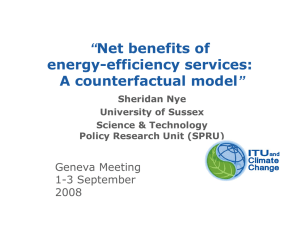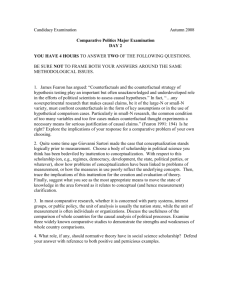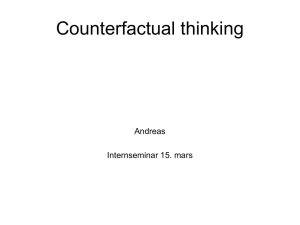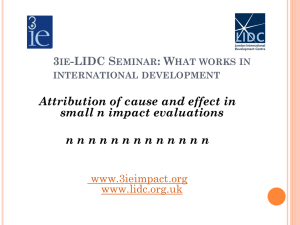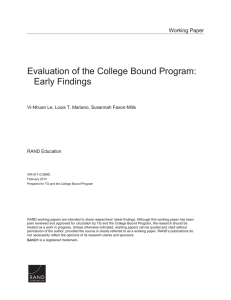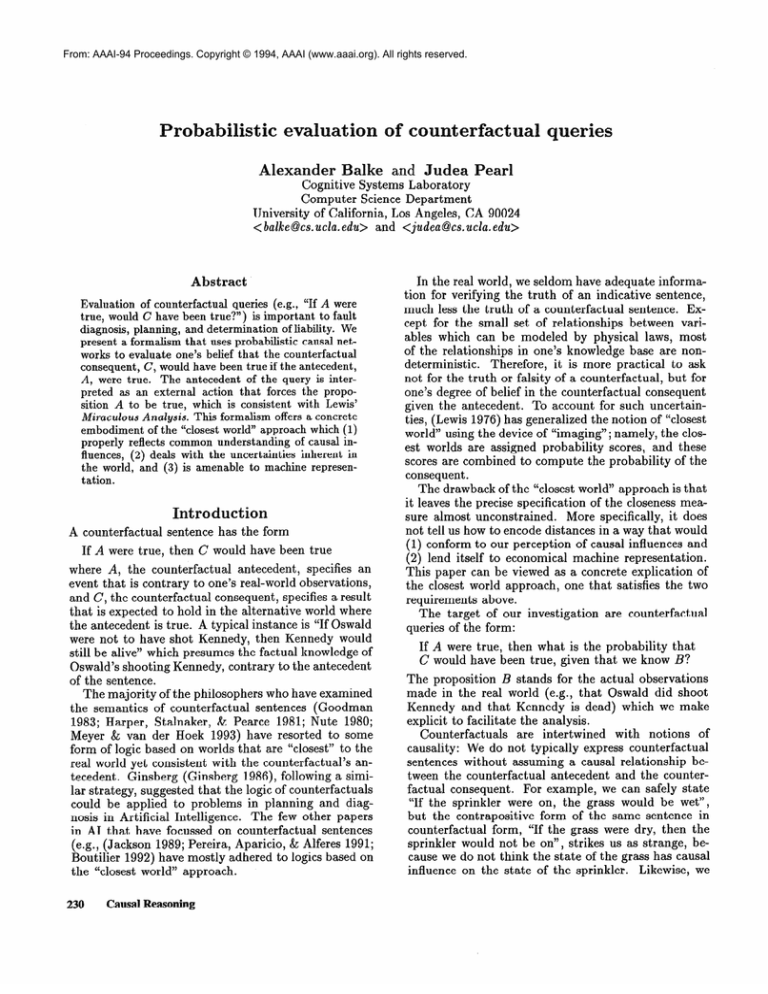
From: AAAI-94 Proceedings. Copyright © 1994, AAAI (www.aaai.org). All rights reserved.
Probabilistic
evaluation Q count erfact ua
Alexander Bake
and Judea
Cognitive Systems Laboratory
Computer Science Department
University of California, Los Angeles, CA 90024
< balke@cs. ucla. edu> and <judia@cs.ucla.edu>
Abstract
Evaluation of counterfactual queries (e.g., “If A were
true, would C have been true?“) is important to fault
diagnosis, planning, and determination
of liability. We
present a formalism that uses probabilistic
causal networks to evaluate one’s belief that the counterfactual
consequent,
C, would have been true if the antecedent,
A, were true. The antecedent of the query is interpreted as an external
action that forces the proposition A to be true, which is consistent
with Lewis’
Miraculous
Analysis. This formalism offers a concrete
embodiment
of the “closest world” approach which (I)
properly reflects common understanding
of causal ininherent in
fluences, (2) deals with the uncertainties
the world, and (3) is amenable to machine representation.
Introduction
A counterfactual
sentence has the form
If A were true, then C would have been true
where A, the counterfactual antecedent, specifies an
event that is contrary to one’s real-world observations,
and C, the counterfactual consequent, specifies a result
that is expected to hold in the alternative world where
the antecedent is true. A typical instance is “If Oswald
were not to have shot Kennedy, then Kennedy would
still be alive” which presumes the factual knowledge of
Oswald’s shooting Kennedy, contrary to the antecedent
of the sentence.
The majority of the philosophers who have examined
the semantics of counterfactual sentences (Goodman
1983; Harper, Stalnaker, & Pearce 1981; Nute 1980;
Meyer & van der Hoek 1993) have resorted to some
form of logic based on worlds that are “closest” to the
real world yet consistent with the counterfactual’s antecedent. Ginsberg (Ginsberg 1986), following a similar strategy, suggested that the logic of counterfactuals
could be applied to problems in planning and diagnosis in Artificial Intelligence.
The few other papers
in AI that have focussed on counterfactual sentences
(e.g., (Jackson 1989; Pereira, Aparicio, & Alferes 1991;
Boutilier 1992) have mostly adhered to logics based on
the “closest world” approach.
230
Causal Reasoning
In the real world, we seldom have adequate information for verifying the truth of an indicative sentence,
much less the truth of a counterfactual sentence. Except for the small set of relationships between variables which can be modeled by physical laws, most
of the relationships in one’s knowledge base are nondeterministic.
Therefore, it is more practical to ask
not for the truth or falsity of a counterfactual, but for
one’s degree of belief in the counterfactual consequent
given the antecedent. To account for such uncertainties, (Lewis 1976) has generalized the notion of “closest
world” using the device of “imaging” ; namely, the closest worlds are assigned probability scores, and these
scores are combined to compute the probability of the
consequent.
The drawback of the “closest world” approach is that
it leaves the precise specification of the closeness measure almost unconstrained.
More specifically, it does
not tell us how to encode distances in a way that would
(1) conform to our perception of causal influences and
(2) lend itself to economical machine representation.
This paper can be viewed as a concrete explication of
the closest world approach, one that satisfies the two
requirements above.
The target of our investigation are counterfactual
queries of the form:
If A were true, then what is the probability that
C would have been true, given that we know B?
The proposition B stands for the actual observations
made in the real world (e.g., that Oswald did shoot
Kennedy and that Kennedy is dead) which we make
explicit to facilitate the analysis.
Counterfactuals
are intertwined with notions of
causality: We do not typically express counterfactual
sentences without assuming a causal relationship between the counterfactual antecedent and the counterfactual consequent. For example, we can safely state
“If the sprinkler were on, the grass would be wet”,
but the contrapositive form of the same sentence in
counterfactual form, “If the grass were dry, then the
sprinkler would not be on”, strikes us as strange, because we do not think the state of the grass has causal
influence on the state of the sprinkler. Likewise, we
do not state “All blocks on this table are green, hence,
had this white block been on the table, it would have
been green”. In fact, we could say that people’s use
of counterfactual statements is aimed precisely at conveying generic causal information, uncontaminated by
specific, transitory observations, about the real world.
Observed facts often do reflect strange combinations
of rare eventualities (e.g., all blocks being green) that
have nothing to do with general traits of influence and
behavior. The counterfactual sentence, however, emphasizes the law-like, necessary component of the relation considered. It is for this reason, we speculate,
that we find such frequent use of counterfactuals in
ordinary discourse.
The importance of equipping machines with the capability to answer counterfactual queries lies precisely
in this causal reading. By making a counterfactual
query, the user intends to extract the generic, necessary
connection between the antecedent and consequent, regardless of the contingent factual information available
at that moment.
Because of the tight connection between counterfactuals and causal influences, any algorithm for computing counterfactual queries must rely heavily on causal
knowledge of the domain. This leads naturally to the
use of probabilistic causal networks, since these networks combine causal and probabilistic knowledge and
permit reasoning from causes to effects as well as, conversely, from effects to causes.
To emphasize the causal character of counterfactuals, we will adopt the interpretation in (Pearl 1993a),
according to which a counterfactual sentence “If it were
A, then B would have been” states that B would prevail if A were forced to be true by some unspecified
action that is exogenous to the other relationships considered in the analysis. This action-based interpretation does not permit inferences from the counterfactual
antecedent towards events that lie in its past. For example, the action-based interpretation would ratify the
counterfactual
If Kennedy were alive today, then the country
would have been in a better shape
but not the counterfactual
If Kennedy were alive today, then Oswald would
have been alive as well.
The former is admitted because the causal influence of
Kennedy on the country is presumed to remain valid
even if Kennedy became alive by an act of God. The
second sentence is disallowed because Kennedy being
alive is not perceived as having causal influence on Oswald being alive. The information intended in the second sentence is better expressed in an indicative mood:
If Kennedy was alive today then he could not have
been killed in Dallas, hence, Jack Ruby would
not have had a reason to kill Oswald and Oswald
would have been alive today.
Our interpretation
of counterfactual
antecedents,
which is similar to Lewis’ (Lewis 1979) Miraculous
Analysis, contrasts with interpretations
that require
that the counterfactual antecedent be consistent with
the world in which the analysis occurs. The set of
closest worlds delineated by the action-based interpretation contains all those which coincide with the factual world except on possible consequences of the action taken. The probabilities assigned to these worlds
will be determined by the relative likelihood of those
consequences as encoded by the causal network.
We will show that causal theories specified in functional form (as in (Pearl & Verma 1991; Druzdzel &
Simon 1993; Poole 1993)) are sufficient for evaluating
counterfactual queries, whereas the causal information
embedded in Bayesian networks is not sufficient for
the task. Every Bayes network can be represented by
several functional specifications, each yielding different evaluations of a counterfactual.
The problem is
that, deciding what factual information deserves undoing (by the antecedent of the query) requires a model
of temporal persistence, and, as noted in (Pearl 1993c),
such a model is not part of static Bayesian networks.
Functional specification, however, implicitly contains
the temporal persistence information needed.
The next section introduces some useful notation for
concisely expressing counterfactual sentences/queries.
We then present an example demonstrating the plausibility of the external action interpretation adopted in
this paper. We then demonstrate that Bayesian networks are insufficient for uniquely evaluating counterfactual queries whereas the functional model is sufficient. A counterfactual query algorithm is then presented, followed by a re-examination of the earlier example with a quantitative analysis using this algorithm. The final section contains concluding remarks.
Notation
Let the set of variables describing the world be designated by X = {Xi, X2,. . . , Xn}. As part of the complete specification of a counterfactual query, there are
real-world observations that make up the background
context. These observed values will be represented in
the standard form 21, x2, . . . , xn. In addition, we must
represent the value of the variables in the counterfactual world. To distinguish between xi and the value
of Xi in the counterfactual world, we will denote the
latter with an asterisk; thus, the value of Xi in the
counterfactual world will be represented by $. We will
also need a notation to distinguish between events that
might be true in the counterfactual world and those
referenced explicitly in the counterfactual antecedent.
The latter are interpreted as being forced to the counterfactual value by an external action, which will be
denoted by a hat (e.g., 2).
Thus, a typical counterfactual query will have the
form “What is P(c* Iti*, a, b)?” to be read as “Given
that we have observed A = a and B = b in the real
Causal Reasoning
231
A
Bob at party
Ann at party
I/):
C
B
S
Scuffle
world, if A were &*, then what is the probability
C would have been c*?”
that
Party example
To illustrate the external-force interpretations of counterfactuals, consider the following interpersonal behaviors of Ann, Bob, and Carl:
o Ann sometimes goes to parties.
o Bob likes Ann very much but is not into the party
scene. Hence, save for rare circumstances, Bob is at
the party if and only if Ann is there.
o Carl tries to avoid contact with Ann since they broke
up last month, but he really likes parties. Thus, save
for rare occasions, Carl is at the party if and only if
Ann is not at the party.
o Bob and Carl truly hate each other and almost always scuffle when they meet.
This situation may be represented by the diamond
structure in Figure 1. The four variables A, B, C, and
S have the following domains:
bE
CE
{
{
{
iy
G Ann is not at the party.
E Ann is at the party.
>
bo s
bl E
E
zy E
Bob is not at the party.
Bob is at the party.
>
Carl is not at the party.
Carl is at the party.
1
z No scuffle between Bob and Carl.
1; E Scuffle between Bob and Carl.
>
{
Now consider the following discussion between two
friends (Laura and Scott) who did not go to the party
but were called by Bob from his home (b = bo):
Laura:
Ann must not be at the party, or Bob
would be there instead of at home.
SE
Scott:
That must mean that
party!
Laura:
If Bob were at the party, then Bob and
Carl would surely scuffle.
Scott:
No. If Bob was there, then Carl would
not be there, .because Ann would have
been at the party.
232
Causal Reasoning
True. But if Bob were at the party even
though Ann was not, then Bob and Carl
would be scuffling.
Scott:
I agree. It’s good that Ann would not
have been there to see it.
Carl at party
Figure 1: Causal structure reflecting the influence that
Ann’s attendance has on Bob and Carl’s attendance,
and the influence that Bob and Carl’s attendance has
on their scuffling.
aE
Laura:
Carl is at the
In the fourth sentence, Scott tries to explain away
Laura’s conclusion by claiming that Bob’s presence
would be evidence that Ann was at the party which
would imply that Carl was not at the party. Scott,
though, analyzes Laura’s counterfactual statement as
an indicative sentence by imagining that she had observed Bob’s presence at the party; this allows her
to use the observation for abductive reasoning. But
Laura’s subjunctive (counterfactual) statement should
be interpreted as leaving everything in the past as it
was (including conclusions obtained from abductive
reasoning from real observations) while forcing variables to their counterfactual values. This is the gist of
her last statement.
This example demonstrates the plausibility of interpreting the counterfactual statement in terms of an
external force causing Bob to be at the party, regardless of all other prior circumstances. The only variables
that we would expect to be impacted by the counterfactual assumption would be the descendants of the
counterfactual variable; in other words, the counterfactual value of Bob’s attendance does not change the
belief in Ann’s attendance from the belief prompted by
the real-world observation.
Probabilistic vs. functional specification
In this section we will demonstrate that functionally
modeled causal theories (Pearl & Verma 1991) are necessary for uniquely evaluating count&factual queries,
while the conditional probabilities used in the standard
specification of Bayesian networks are insufficient for
i obtaining unique solutions.
Reconsider the party example limited to the two
variables A and B, representing Ann and Bob’s attendance, respectively. Assume that previous behavior
shows P(biJai) = 0.9 and P(bolao) = 0.9. We observe
that Bob and Ann are absent from the party and we
wonder whether Bob would be there if Ann were there
P(bT ItiT, ao, bo). The answer depends on the mechanism that accounts for the 10% exception in Bob’s
behavior. If the reason Bob occasionally misses parties (when Ann goes) is that he is unable to attend (
e.g., being sick or having to finish a paper for AAAI),
then the answer to our query would be 90%. However, if the only reason for Bob’s occasional absence
(when Ann goes) is that he becomes angry with Ann
(in which case he does exactly the opposite of what she
does), then the answer to our query is lOO%, because
Ann and Bob’s current absence from the party proves
that Bob is not angry. Thus, we see that the information contained in the conditional probabilities on the
observed variables is insufficient for answering counterfactual queries uniquely; some information about
the mechanisms responsible for these probabilities is
needed as well.
The functional specification, which provides this information, models the influence of A on B by a deterministic function
where eb stands for all unknown factors that may influence B and the prior probability distribution P(cb)
quantifies the likelihood of such factors. For example,
whether Bob has been grounded by his parents and
whether Bob is angry at Ann could make up two possible components of eb. Given a Specific value for Eb,
B becomes a deterministic function of A; hence, each
value in eb’s domain specifies a response function that
maps each value of A to some value in B’s domain. In
general, the domain for eb could contain many components, but it can always be replaced by an equivalent
variable that is minimal, by partitioning the domain
into equivalence regions, each corresponding to a single response function (Pearl 199313). Formally, these
equivalence classes can be characterized as a function
rb : dom(rb) + N, as follows:
rb(cb)
0
1
2
3
=
if
if
if
if
Fb(aO,
Fb(ae,
Fb(ac,
Fb(aO,
Eb) =
eb) =
Eb) =
Eb) =
0
0
1
I
&
&
&
&
Fb(ai, Eb) =
Fb(ar, Eb) =
Fb(al,eb) =
Fb(ai, Eb) =
0
I
0
I
Obviously, rb can be regarded as a random variable
that takes on as many values as there are functions
We will refer to this domainbetween A and B.
minimal variable as a response-function
variable.
rb
is closely related to the potential response variables in
Rubin’s model of counterfactuals (Rubin 1974), which
was introduced to facilitate causal inference in statistical analysis (Balke & Pearl 1993).
For this example, the response-function variable for
B has a four-valued domain rb E (0, 1,2,3} with the
following functional specification:
b
=
fb(%
rb)
=
hb,&)
(1)
where
hb,O(a)
=
b0
(2)
hb,l(a)
=
bo
bl
hb,2(a)
=
bl
bo
hb,3(a)
=
h
if a = a0
ifa=ar
ifa=ac
if a = al
(5)
specify the mappings of the individual response functions. The prior probability on these response functions P(rb) in conjunction with fb(a, rb) fully parameterizes the model.
Given P(rb), we can uniquely evaluate the counterfactual query “What is P(bi Iii:, ao, bo)?” (i.e., “Given
A = a0 and B = bo, if A were al, then what is the
probability that B would have been bl?“). The action-
based interpretation of counterfactual antecedents implies that the disturbance cb, and hence the responsefunction rb, is unaffected by the actions that force the
counterfactual values’; therefore, what we learn about
the response-function from the observed evidence is applicable to the evaluation of belief in the counterfactual consequent. If we observe (ao, bo), then we are
certain that rb E (0, l}, an event having prior probability P( rb = 0) + P(rb = 1). Hence, this evidence
leads to an updated posterior probability for rb (let
$(rb)
p(rb)
= (P(rb=o),
=
P(rb=l),
?(rblaO,bO)
P(r&),
P(r&)))
=
P(rb=l)
P(rb=o)
P(rb=o)
-kP(rb=l)
’P(rb=o)
+ P(rb=l)
According to Eqs. 1-5, if A were forced to al, then
B would have been bl if and only if rb E { 1,3}, which
has probability P’(rb=I) -I- P’(rb=3) = P’(rb=I).
This
is exactly the solution to the counterfactual query,
P(bTIiiT, ao, bo)
= P’(rb=l)
P( rb=l)
=
P(rb=o)
This analysis is consistent with
account of (Skyrms 1980).
What if we are provided only
instead of
probability (P(bla))
Th ese two
(fb(% rb) and p(rb))?
lated by:
P(hlao)
=
P(r&)
+ P(rb=l)
the prior
*
propensity
with the conditional
a functional model
specifications are re+ P(r&)
P(hlal)
= P(rb=l) + P(r&).
which show that P(rb) is not, in general, uniquely determined by the conditional distribution P(bla).
Hence, given a counterfactual query, a functional
model always leads to a unique solution, while a
Bayesian network seldom leads to a unique solution,
depending on whether the conditional distributions of
the Bayesian network sufficiently constrain the prior
distributions of the response-function variables in the
corresponding functional model.
In practice, specifying a functional model is not as
daunting as one might think from the example above.
In fact, it could be argued that the subjective judgments needed for specifying Bayesian networks (i.e.,
judgments about conditional probabilities)
are generated mentally on the basis of a stored model of
For example, in the noisyfunctional relationships.
OR mechanism, which is often used to model causal
interactions, the conditional probabilities are derivatives of a functional model involving AND/OR gates,
corrupted by independent binary disturbances.
This
model is used, in fact, to simplify the specification of
conditional probabilities in Bayesian networks (Pearl
1988).
observation
‘An
communication)
by
D.
Heckerman
(personal
Causal Reasoning
233
Evaluating counterfactual queries
From the last section, we see that the algorithm for
evaluating counterfactual queries should consist of: (1)
compute the posterior probabilities for the disturbance
variables, given the observed evidence; (2) remove the
observed evidence and enforce the value for the counterfactual antecedent; finally, (3) evaluate the probability of the counterfactual consequent, given the’conditions set in the first two steps.
An important point to remember is that it is not
enough to compute the posterior distribution of each
disturbance variable (e) separately and treat those
variables as independent quantities. Although the disturbance variables are initially independent, the evidence observed tends to create dependencies among the
parents of the observed variables, and these dependencies need to be represented in the posterior distribution. An efficient way to maintain these dependencies
is through the structure of the causal network itself.
Thus, we will represent the variables in the counterfactual world as distinct from the corresponding variables in the real world, by using a separate network
for each world. Evidence can then be instantiated on
the real-world network, and the solution to the counterfactual query can be determined as the probability
of the counterfactual consequent, as computed in the
counterfactual network where the counterfactual antecedent is enforced. But, the reader may ask, and
this is key, how are the networks for the real and counterfactual worlds linked? Because any exogenous variable, Ed, is not influenced by forcing the value of any
endogenous variables in the model, the value of that
disturbance will be identical in both the real and counterfactual worlds; therefore, a single variable can represent the disturbance in both worlds. ca thus becomes
a common causal influence of the variables representing A in the real and counterfactual networks, respectively, which allows evidence in the real-world network
to propagate to the counterfactual network.
Assume that we are given a causal theory T =
(O,O~)
as defined in (Pearl & Verma 1991).
D
is a directed acyclic graph (DAG) that specifies the
structure of causal influences over a set of variables
x = {X1,X2,...
, Xra}. 00 specifies a functional mapping xi = fi(pa(xi), ei) (pa(xi) represents the value of
Xi’s parents) and a prior probability distribution P(Q)
for each disturbance ~a’(we assume that Q’S domain is
discrete; if not, we can always transform it to a discrete domain such as a response-function variable). A
counterfactual query “What is P(c*Iti*, obs)?” is then
posed, where c* specifies counterfactual values for a set
of variables C c X, 6* specifies forced values for the
set of variables in the counterfactual antecedent, and
obs specifies observed evidence. The solution can be
evaluated by the following algorithm:
t 1. From the known causal theory T create a Bayesian
network < G, P > that explicitly models the disturbances as variables and distinguishes the real world
234
Causal Reasoning
variables from their counterparts in the counterfactual world. G is a DAG defined over the set of variables V = XUX*Uc,whereX=(Xr,X2
,..., Xn}
is the original set of variables modeled by T, X* =
is their counterfactual world rep{x~,x;,...,x;~
resentation, and E = (~1, ~2, . . . , en) represents the
set of disturbance variables that summarize the common external causal influences acting on the members of X and X*. P is the set of conditional probability distributions P( K Ipa( E)) that parameterizes
the causal structure G.
in D, then Xj E pa(Xi)
and
If Xj E pa(&)
X! E pa(Xr) in G (pa(Xi) is the set of Xi’s parents). In addition, I E pa(Xi) and ~a E pa(Xr)
in G. The conditional probability distributions for
the Bayesian network are generated from the causal
theory :
P(xiIpax
(xi),fi) =
where pax(xi)
X I7 pa(xi).
1
0
if xi = fi(pa,(xi),
otherwise
Q)
is the set of values of the variables in
P(xa* IpaX* (x:i*), Q)
=
P(xi Ipax (xi), I)
whenever xi = xi* and pax*(xr) = pax(xi).
P(Q) is
the same as specified by the functional causal theory
T.
2. Observed evidence. The observed evidence obs is instantiated on the real world variables X corresponding to obs.
3. Counterfactual antecedent. For every forced value in
the counterfactual antecedent specification St E ii*,
= 2:)
apply the action-based semantics of set(Xf
(see (Pearl 199313; Spirtes, Glymour, & Scheines
1993)), which amounts to severing all the causal
edges from pa(X,*) to X,* for all x;;* E &* and instantiating X8? to the value specified in it*.
4. Belief propagation. After instantiating the observations and actions in the network, evaluate the belief
in c* using the standard belief update methods for
Bayesian networks (Pearl 1988). The result is the
solution to the counterfactual query.
In the last section, we noted that the conditional
distribution P(xklpa(Xk))
for each variable Xk E X
constrains, but does not uniquely determine, the prior
distribution P(Q) of each disturbance variable. Although the composition of the external causal influences are often not precisely known, a subjective distribution over response functions may be assessable. If
a reasonable distribution can be selected for each relevant disturbance variable, the implementation of the
above algorithm is straightforward and the solution is
unique; otherwise, bounds on the solution can be obtained using convex optimization techniques.
(Balke
& Pearl 1993) demonstrates this optimization task in
deriving bounds on causal effects from partially controlled experiments.
A network generated by the above algorithm may
often be simplified. If a variable X* in the counterfactual world is not a causal descendant of any of the
variables mentioned in the counterfactual antecedent
&*, then Xj and XT will always have identical distributions, because the causal influences that functionally
determine Xj and X.J are identical. Xj and XT may
therefore be treated as the same variable. In this case,
the conditional distribution P(xj Ipa(
is sufficient,
and the disturbance variable ej and its prior distribution need not be specified.
Party again
Let us revisit the party example. Assuming we have
observed that Bob is not at the party (6 = bo), we want
to know whether Bob and Carl would have scuffled if
Bob were at the party (i.e., “What is P(si l&i, bo)?“).
Suppose that we are supplied with the following
causal theory for the model in Figure 1:
fa @a)
a=
b=
c =
s=
fb (a,
= ha,raO
=
rb)
f&v,)
fs (b,c, 4
hb,Pb(a)
= h,,.,(a)
= hs,rs(h c)
where
P(ra)
p(rb)
P(5)
=
=
0.40
0.60
if ra = 0
if ra = 1
0.07
0.90
0.03
0
if
if
if
if
rb =
r1, =
rb =
rb =
if rc = 0
( 0.10
if rc = 3
0.05
0.90
0.05
if rs = 0
if rs = 8
if rs
9
otherwise
0
Figure 3: To evaluate the query P(si I&i, bo), the network of Figure 2 is instantiated with observation bo
and action &; (links pointing to bi are severed).
0
I
2
3
( 0.05
=
and
hs,o(hc) =
h,,s(hc) =
h&b,
c)
=
Figure 2: Bayesian model for evaluating counterfactual
queries in the party example. The variables marked
with * make up the counterfactual world, while those
without *, the factual world. The r variables index the
response functions.
ha,o()
=
a0
ha,l()
=
al
so
SO
if
(b,
c)
#
(h,
cl)
~1
if
(b,
c)
=
@I,
cl)
SO
if
(b,
c)
E
{(h,
~1
if (b, c)
E {(h
CO), (bo,
co),
~1))
(h,cl)l
The response functions for B and C (ha,,, and hC,Tc
both take the same form as that given in Eq. (5).
These numbers reflect the authors’ understanding of
the characters involved. For example, the choice for
P(rb) represents our belief that Bob usually is at the
party if and only if Ann is there (rb = 1). However,
we believe that Bob is sometimes (- 7% of the time)
unable to go to the party (e.g., sick or grounded by his
parents); this exception is represented by rb = 0. In
addition, Bob would sometimes (- 3% of the time) go
to the party if and only if Ann is not there (e.g., Bob
is in a spiteful mood); this exception is represented by
represents our understanding
rb = 2. Finally, P(rs)
that there is a slight chance (5%) that Bob and Carl
would not scuffle regardless of attendance (rs = 0),
and the same chance (P(rs=9)
= 5%) that a scuffle
would take place either outside or inside the party (but
not if only one of then shows up).
Figure 2 shows the Bayesian network generated from
step 1 of the algorithm. After instantiating the real
world observations (bo) and the actions (ii) specified
by the counterfactual antecedent in accordance with
steps 2 and 3, the network takes on the configuration
shown in Figure 3.
If we propagate the evidence through this Bayesian
network, we will arrive at the solution
P(s$;,
bo)
=
0.79.
CausalReasoning
235
which is consistent with Laura’s assertion that Bob and
Carl would have scuffled if Bob were at the party, given
that Bob actually was not at the party. Compare this
to the solution to the indicative query that Scott was
thinking of:
P(slIh)
-0
PE
g
/&lo= /& + C,,3(S~,,3y(o’-
Go)
q, e &lo=&,C
- C,,,St(SC,,,St)-lS
0.11.
=
we
To evaluate the counterfactual query P(x*lii*o)
first update the prior distribution of the disturbances
by the observations 0’:
that is, if we had observed that Bob was at the party,
then Bob and Carl would probably not have scuffled.
This emphasizes the difference between counterfactual
and indicative queries and their solutions.
We then evaluate the means &la.o
and variances
c x+,xLl~oOof the variables in the counterfactual world
(x*) under the action k* using Eqs. (13) and (14), with
Co and p” replacing C and p.
Special Case: Linear-Gaussian Models
Assume that knowledge is specified by the structural
equation model
ii! =
where B is a triangular
causal model that is a
mean i& and covariance
sumed to be Gaussian).
the observable variables
FX
c x,x
matrix (corresponding to a
DAG), and we are given the
C E,Eof the disturbances ?(asThe mean and covariance of
Z are then given by:
=
S&
(6)
=
S&,3
(7)
c x,x - ~x,oq$~o,,
=
(9)
where, for every pair of sub-vectors, z’and 6, of d, CZ,w
is the sub-matrix of Cx,x with entries corresponding to
the components of Z’and 5. Singularities of C terms
are handled by appropriate means.
Similar formulas apply for the mean and covariance
of ac’under an action z. B is replaced by the actionpruned matrix B = [6ij] defined by:
&ij
i
=
ij
ifXiEg
otherwise
The mean and covariance of 3 under g is evaluated
using Eqs. (6) and (7), where B is replaced by &:
FX
2x,x
=
Lq!&
(11)
=
~c~,bgt
(12)
We can then evaluate the distriwhere 3 = (I - B)-l.
bution of Z under the action z by conditioning on the
value of the action z according to Eqs. (8) and (9):
-a
A
=
2
Pxla
c x,x)&
g
YiIx,xla= 2x,1 - ilz,aC,l,Ca,x
PXlii
236
Causal Reasoning
= ix + YiI,,a2,l,(ii
A
=
c;,,,,
= IQ,
- Q,(Q
,a)-12;
tx
where, from Eqs. (11) and (12), 3: = SFz and Y&,, =
BZ+Z
where S = (I - B)-l.
Under such a model, there are well-known formulas
(Whittaker 1990, p. 163) f or evaluating the conditional
mean and covariance of 3c under some observations 0’:
-+
PO)
Pxlo = Fx + ~,,oz$(~(8)
c x,x10
c x*,x*pi*0
- 5,)
(13)
(14)
Pq E&
It’is clear that this procedure can be applied to nontriangular matrices, as long as S is non-singular.
In
fact, the response-function formulation opens the way
to incorporate feedback loops within the Bayesian network framework.
Conclusion
The evaluation of counterfactual queries is applicable
to many tasks. For example, determining liability of
actions (e.g., “If you had not pushed the table, the
glass would not have broken; therefore, you are liable”). In diagnostic tasks, counterfactual queries can
be used to determine which tests to perform in order
to increase the probability that faulty components are
identified. In planning, counterfactuals can be used
for goal regression or for determining which actions,
if performed, could have avoided an observed, unexpected failure. Thus, counterfactual reasoning is an
essential component in plan repairing, plan compilation and explanation-based learning.
In this paper we have presented formal notation,
semantics, representation scheme, and inference algorithms that facilitate the probabilistic evaluation
of counterfactual queries. World knowledge is represented in the language of modified causal networks,
whose root nodes are unobserved, and correspond to
possible functional mechanisms operating among families of observables. The prior probabilities of these root
nodes are updated by the factual information transmitted with the query, and remain fixed thereafter. The
antecedent of the query is interpreted as a proposition
that is established by an external action, thus pruning the corresponding links from the network and facilitating standard Bayesian-network computation to
determine the probability of the consequent.
At this time the algorithm has not been implemented
but, given a subjective prior distribution over the response variables, there are no new computational tasks
introduced by this formalism, and the inference process
follows the standard techniques for computing beliefs
in Bayesian networks (Pearl 1988). If prior distributions over the relevant response-function variables cannot be assessed, we have developed methods of using
the standard conditional-probability
specification of
Bayesian networks to compute upper and lower bounds
on counterfactual probabilities (Balke & Pearl 1994).
The semantics and methodology introduced in this
paper can be adopted to nonprobabilistic formalisms
as well, as long as they support two essential components: abduction (to abduce plausible functional mechanisms from the factual observations) and causal projection (to infer the consequences of the action-like antecedent).
We should note, though, that the license
to keep the response-function variables constant stems
from a unique feature of counterfactual queries, where
the factual observations are presumed to occur not earlier than the counterfactual action. In general, when
an observation takes place before an action, constancy
of response functions would be justified if the environment remains relatively static between the observation
and the action (e.g., if the disturbance terms ei) represent unknown pre-action conditions).
However, in
a dynamic environment subject to stochastic shocks
a full temporal analysis using temporally-indexed networks may be warranted or, alternatively, a canonical
model of persistence should be invoked (Pearl 1993c).
Acknowledgments
The research was partially supported by Air Force
grant #AFOSR
90 0136, NSF grant #IRI-9200918,
Northrop Micro grant #92-123, and Rockwell Micro
grant #92-122. Alexander Balke was supported by the
Fannie and John Hertz Foundation. This work benefitted from discussions with David Heckerman.
References
Balke, A., and Pearl, J. 1993. Nonparametric bounds
on causal effects from partial compliance data. Technical Report R-199, UCLA Cognitive Systems Lab.
Balke, A., and Pearl, J. 1994. Bounds on probabilistitally evaluated counterfactual queries. Technical Report R-213-B, UCLA Cognitive Systems Lab.
Boutilier, C. 1992. A logic for revision and subjunct ive queries. In Proceedings Tenth National Conference on Artificial Intelligence,
609-15. Menlo Park,
CA: AAAI Press.
Druzdzel, M. J., and Simon, H. A. 1993. Causality
in bayesian belief networks. In Proceedings of the 9th
Annual Conference
on Uncertainty
ligence (UAI-93),
3-11.
Ginsberg,
Intelligence
M. L.
1986.
in Artificial
Counterfactuals.
Intel-
Artificial
30:35-79.
Goodman, N. 1983. Fact, Fiction, and Forecast. Cambridge, MA: Harvard University Press, 4th edition.
Harper, W. L.; Stalnaker, R.; and Pearce, G., eds.
1981. Ifs: Conditionals,
Belief, Decision,
Chance,
and Time. Boston, MA: D. Reidel.
Jackson, P. 1989. On the semantics of counterfactuals. In Proceedings of the Eleventh International
Joint
Conference
on Artificial Intelligence,
1382-7 vol. 2.
Palo Alto, CA: Morgan Kaufmann.
Lewis, D. 1976. Probability of conditionals and conditional probabilities. The Philosophical Review 85:297315.
Lewis, D.
1979.
Counterfactual
time’s arrow. Noiis 455-476.
dependence
and
Meyer, J.-J., and van der Hoek, W. 1993. Counterfactual reasoning by (means of) defaults. Annals of
Mathematics
and Artificial
Intelligence
Nute, D. 1980. Topics in Conditional
D. Reidel.
9:345-360.
Logic. Boston:
Pearl, J., and Verma, T. 1991. A theory of inferred
causation. In Principles of Knowledge Representation
and Reasoning:
Proceedings
of the Second International Conference,
441-452. San Mateo, CA: Morgan
Kaufmann.
Pearl, J.
1988. Probabilistic Reasoning in Intelligent
Networks of Plausible Inference. San Mateo,
Systems:
CA: Morgan Kaufman.
Pearl, J. 1993a. From Adams’ conditionals to default expressions, causal conditionals, and counterfactuals. Technical Report R-193, UCLA Cognitive Systems Lab. To appear in Festschrift for Ernest Adams,
Cambridge University Press, 1994.
Pearl, J. 1993b. From Bayesian networks to causal
networks. Technical Report R-195-LLL, UCLA Cognitive Systems Lab. Short version: Statistical Science
8(3):266-269.
Pearl, J. 1993c. From conditional oughts to qualitative decision theory. In Uncertainty in Artificial Intelligence: Proceedings of the Ninth Conference,
12-20.
Morgan Kaufmann.
Pereira, L. M.; Aparicio, J. N.; and Alferes, J. J. 1991.
Counterfactual reasoning based on revising assumptions. In Logic Programming:
Proceedings of the 1991
International
Symposium, 566-577.
Cambridge, MA:
MIT Press.
Poole, D. 1993. Probabilistic Horn abduction and
Bayesian networks. Artificial Intelligence
64( 1):81130.
1974.
Estimating causal effects of
Rubin, D. B.
treatments in randomized and nonrandomized studies. Journal of Educational Psychology 66(5):688-701.
Skyrms, B. 1980. The prior propensity account of
subjunctive conditionals. In Harper, W.; Stalnaker,
R.; and Pearce, G., eds., Ifs. D. Reidel. 259-265.
Spirtes, P.; Glymour, C.; and Scheines, R. 1993. Causation, Prediction,
and Search. New York: Springer.
Whittaker,
tivariate
J. 1990. Graphical Models in Applied MulNew York: John Wiley & Sons.
Statistics.
Causal Reasoning
237


